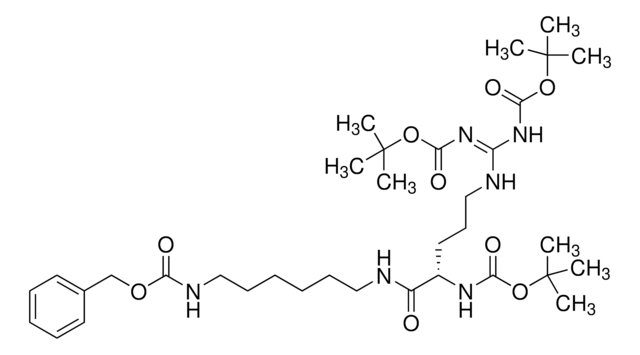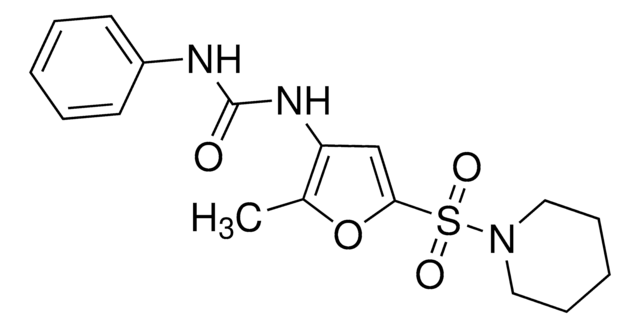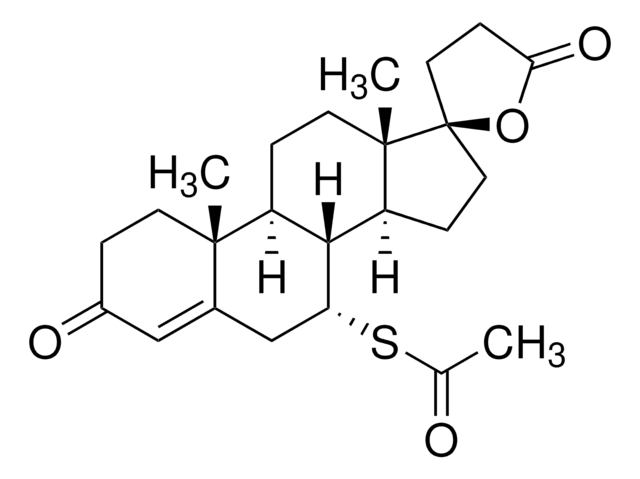推薦產品
化驗
≥98% (HPLC)
形狀
powder
顏色
white to beige
溶解度
DMSO: 2 mg/mL, clear
儲存溫度
2-8°C
SMILES 字串
O=C(N1CCCCC1)OC2=NSN=C2N3CCCCC3
應用
Lalistat 2 has been used as a lysosomal acid lipase (LAL) inhibitor to study its effects on hypoxia-inducible factor (HIF) in mice. It has also been used as a LAL inhibitor to study LAL activity on dried blood spot cards.
生化/生理作用
Lalistat-2 is a potent and specific competitive inhibitor of the lysosomal acid lipase (LAL/Lipa). Lalistat-2 affects lipid droplets morphology and localization.
儲存類別代碼
11 - Combustible Solids
水污染物質分類(WGK)
WGK 3
閃點(°F)
Not applicable
閃點(°C)
Not applicable
客戶也查看了
Maidina Tuohetahuntila et al.
The Journal of biological chemistry, 292(30), 12436-12448 (2017-06-16)
Activation of hepatic stellate cells (HSCs) is a critical step in the development of liver fibrosis. During activation, HSCs lose their lipid droplets (LDs) containing triacylglycerols (TAGs), cholesteryl esters, and retinyl esters (REs). We previously provided evidence for the presence
Chiara Pavanello et al.
Pharmacological research, 147, 104362-104362 (2019-07-23)
Lysosomal acid lipase (LAL) is responsible for the hydrolysis of cholesteryl esters (CE) and triglycerides (TG) within the lysosomes; generated cholesterol and free fatty acids (FFA) are released in the cytosol where they can regulate their own synthesis and metabolism.
Stefanie Schlager et al.
Oncotarget, 8(25), 40037-40051 (2017-04-14)
Degradation of lysosomal lipids requires lysosomal acid lipase (LAL), the only intracellular lipase known to be active at acidic pH. We found LAL to be expressed in murine immune cells with highest mRNA expression in macrophages and neutrophils. Furthermore, we
Anton I Rosenbaum et al.
Journal of medicinal chemistry, 53(14), 5281-5289 (2010-06-19)
Niemann-Pick type C (NPC) disease is a lysosomal storage disorder characterized at the cellular level by abnormal accumulation of cholesterol and other lipids in lysosomal storage organelles. Lysosomal acid lipase (LAL) has been recently identified as a potential therapeutic target
Xinlei Li et al.
Frontiers in cell and developmental biology, 9, 640667-640667 (2021-04-06)
Extracellular vesicles (EVs) are membrane-limited nanoparticles that are liberated by cells and contain a complex molecular payload comprising proteins, microRNA, RNAs, and lipids. EVs may be taken up by other cells resulting in their phenotypic or functional reprogramming. In the
我們的科學家團隊在所有研究領域都有豐富的經驗,包括生命科學、材料科學、化學合成、色譜、分析等.
聯絡技術服務









